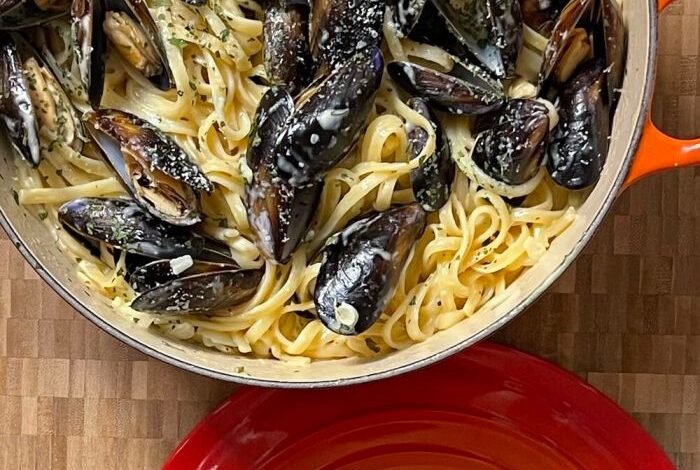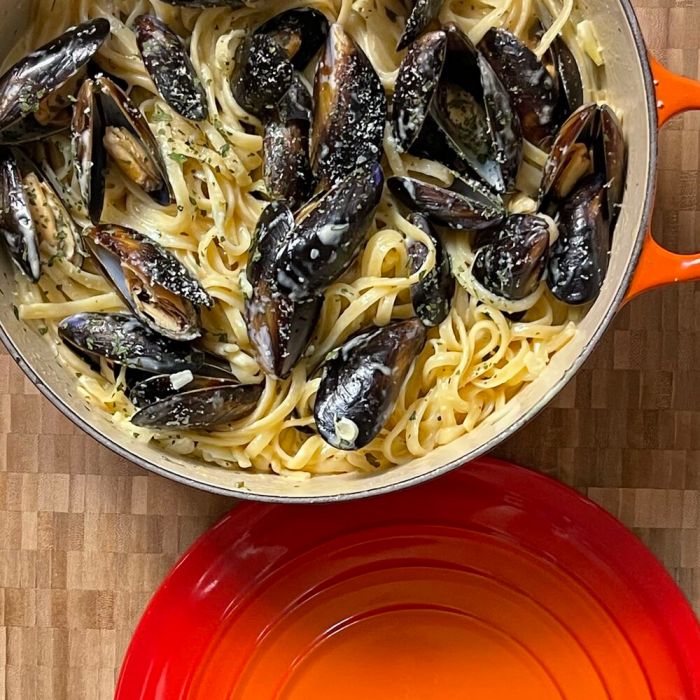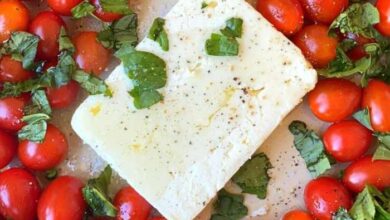
Mussels and Pasta with Creamy Wine Sauce: A Deliciously Simple Recipe
Mussels and pasta with creamy wine sauce is a dish that’s as satisfying as it is elegant. It’s a classic combination that’s enjoyed all over the world, and for good reason. The delicate sweetness of the mussels pairs perfectly with the rich, creamy sauce, and the pasta provides a hearty base for the dish.
This recipe is a great way to impress your friends and family, and it’s surprisingly easy to make.
The origins of this dish can be traced back to the coastal regions of Italy, where mussels and pasta are both staples of the cuisine. The creamy wine sauce is thought to have been developed in the 19th century, and it quickly gained popularity as a delicious and affordable way to enjoy seafood.
Today, this dish is enjoyed all over the world, and it continues to be a favorite among seafood lovers.
Mussels and Pasta with Creamy Wine Sauce: A Culinary Delight

A symphony of flavors and textures, mussels and pasta with creamy wine sauce is a dish that has captured the hearts and palates of food enthusiasts worldwide. Its simple yet elegant presentation, coupled with its rich and comforting taste, makes it a perennial favorite for both casual dining and special occasions.
Origins and Cultural Significance
The origins of this dish can be traced back to the coastal regions of Italy, where fresh seafood and pasta are culinary staples. The combination of mussels, pasta, and creamy wine sauce reflects the region’s rich culinary heritage, where simple ingredients are transformed into exquisite dishes.
This dish is particularly popular in areas like Liguria and Tuscany, where the abundance of fresh mussels and the tradition of using white wine in cooking have contributed to its evolution.
Key Ingredients and Their Roles
- Mussels:Fresh, plump mussels are the star ingredient, adding a briny and slightly sweet flavor to the dish. Their texture is tender and juicy, providing a satisfying contrast to the creamy sauce and the pasta.
- Pasta:Typically, thin spaghetti or linguine are used, as their delicate texture complements the creamy sauce and the mussels. The pasta absorbs the flavors of the sauce, creating a harmonious blend of tastes.
- White Wine:The foundation of the creamy sauce, white wine adds a bright acidity and complexity to the dish. Dry white wines, such as Sauvignon Blanc or Pinot Grigio, are commonly used, as their subtle fruit notes and crispness enhance the overall flavor profile.
- Heavy Cream:The cream adds richness and a velvety texture to the sauce. It binds the flavors together and creates a luxuriously smooth mouthfeel.
- Garlic:A touch of garlic adds a pungent aroma and a hint of savory flavor to the sauce.
- Shallots:Similar to garlic, shallots contribute a subtle sweetness and depth of flavor to the sauce.
- Parsley:A garnish of fresh parsley adds a vibrant green hue and a refreshing touch of herbaceousness to the dish.
Mussel Preparation
Fresh mussels are a key ingredient for a delicious pasta dish. To ensure the best flavor and texture, proper preparation is crucial. This involves cleaning the mussels thoroughly and checking for freshness.
Cleaning Mussels
Cleaning mussels is essential to remove any grit, sand, or debris that may be clinging to the shells. Here’s a step-by-step guide:
- Rinse thoroughly:Place the mussels in a large bowl filled with cold water. Gently scrub the shells with your hands or a brush to remove any visible dirt.
- Remove beards:Mussels have a tough, fibrous beard that needs to be removed. To do this, firmly grasp the beard (the stringy part protruding from the shell) and pull it away from the mussel.
- Discard any damaged mussels:Inspect each mussel for any signs of damage or broken shells. Discard any mussels that are open or have a cracked shell, as they may be contaminated.
- Soak in cold water:After cleaning, soak the mussels in a large bowl of cold water for at least 30 minutes. This helps to remove any remaining sand or grit and ensures the mussels are plump and juicy.
Checking for Freshness
Fresh mussels should have a closed shell and a fresh, briny scent. Here are some signs to look for:
- Closed shells:Mussels should be tightly closed. If the shells are open, tap them gently. If they close, they are still alive and fresh.
- Fresh scent:Fresh mussels should have a distinct, briny odor. Avoid any mussels that have a foul or ammonia-like smell, as this indicates spoilage.
- Firm texture:Fresh mussels should feel firm to the touch. Avoid any mussels that are soft or mushy, as they may be past their prime.
Storing Mussels
Proper storage is essential for maintaining the freshness of mussels.
- Refrigerate:Store mussels in the refrigerator in a single layer in a container with a damp cloth or paper towel. This helps to keep them moist and prevents them from drying out.
- Store for a short time:Mussels are best eaten fresh. They can be stored in the refrigerator for up to 24 hours, but their quality will decline after that.
- Avoid freezing:Freezing mussels is not recommended, as it can damage their texture and flavor.
Cooking Techniques
There are several methods for cooking mussels, each with its own advantages and disadvantages.
Steaming
Steaming is a simple and effective method for cooking mussels. It allows the mussels to cook in their own juices, preserving their natural flavor.
Mussels and pasta with creamy wine sauce is a dish that always makes me feel fancy, but sometimes I crave something simpler. For those nights, I turn to a classic simple mac and cheese recipe. It’s a comforting meal that’s perfect for a cozy evening in.
But even with its simplicity, a good mac and cheese can be just as satisfying as a more elaborate dish like mussels and pasta. It all comes down to using fresh ingredients and a little bit of love, no matter what you’re cooking.
- Advantages:Steaming preserves the natural flavor of the mussels, and it is a quick and easy cooking method.
- Disadvantages:Steaming may not be suitable for all recipes, as it does not allow for browning or caramelization.
Sauteing
Sauteing is a popular method for cooking mussels, as it allows for browning and caramelization.
Mussels and pasta with creamy wine sauce is a dish that always hits the spot, especially when paired with a simple side. For a quick and easy accompaniment, I love making microwave corn on the cob. It’s a perfect way to add a touch of sweetness and freshness to the meal, and it complements the savory flavors of the mussels and pasta beautifully.
Plus, it’s a breeze to prepare, leaving you more time to enjoy the deliciousness!
- Advantages:Sauteing adds a rich, savory flavor to the mussels, and it is a versatile cooking method that can be used in many recipes.
- Disadvantages:Sauteing can dry out the mussels if they are not cooked properly.
Baking
Baking is a less common method for cooking mussels, but it can be a good option for creating a flavorful and comforting dish.
- Advantages:Baking allows for the mussels to cook slowly and evenly, resulting in a tender and juicy texture.
- Disadvantages:Baking can be a time-consuming cooking method, and it may not be suitable for all recipes.
Pasta Selection and Cooking
The choice of pasta is crucial for a successful Mussels and Pasta with Creamy Wine Sauce dish. The pasta should complement the mussels and creamy sauce, providing a textural contrast and acting as a vessel for the flavorful sauce.
Pasta Types
The type of pasta you choose can significantly impact the overall experience of your dish. Here are some excellent pasta choices that complement mussels and creamy wine sauce:
- Linguine:This long, flat pasta is ideal for holding the creamy sauce and its smooth surface provides a pleasing contrast to the mussels.
- Spaghetti:Another classic choice, spaghetti’s long strands provide a good surface area for the sauce to cling to, and its texture is perfect for twirling around a fork.
- Fettuccine:With its wider, ribbon-like shape, fettuccine offers a more substantial bite and effectively captures the creamy sauce.
- Orecchiette:These small, ear-shaped pasta are perfect for scooping up the creamy sauce and the mussels. Their slightly rough surface also helps the sauce cling.
Pasta Cooking Techniques
The key to perfect pasta is achieving al dente consistency, which means the pasta is cooked through but still has a slight bite. This is essential for a good balance of texture and flavor.
- Use plenty of water:A large pot of boiling water ensures that the pasta has enough room to cook evenly and prevents the temperature from dropping too much when the pasta is added.
- Salt the water:Adding salt to the boiling water seasons the pasta and enhances its flavor. Aim for a salinity similar to seawater.
- Don’t overcrowd the pot:Adding too much pasta to the pot can lower the water temperature and prevent it from returning to a boil quickly. This can lead to uneven cooking.
- Stir occasionally:Stirring the pasta prevents it from sticking together and ensures even cooking.
- Check for doneness:Taste a piece of pasta to determine if it’s cooked al dente. It should have a slight resistance when bitten.
Pasta Draining and Preventing Sticking
Proper draining and handling of the pasta are crucial to prevent it from sticking together and ensure it remains al dente.
- Drain the pasta quickly:Use a colander to drain the pasta, but do not overdrain it. The pasta should still be slightly moist.
- Toss with sauce immediately:Once drained, immediately toss the pasta with the sauce to prevent it from sticking.
- Add a tablespoon of pasta water:Adding a tablespoon of pasta water to the sauce helps to create a smoother, creamier sauce and prevents the pasta from sticking.
Creamy Wine Sauce
The creamy wine sauce is the heart and soul of this dish, marrying the delicate flavors of the mussels with the richness of the sauce. The wine you choose plays a crucial role in shaping the sauce’s character, and its interaction with the mussels is a key factor in achieving a harmonious balance of flavors.
Wine Selection and Flavor Profiles
The choice of wine for your creamy sauce is a matter of personal preference, but some wines work better than others with mussels. The ideal wine should complement the seafood’s delicate flavor without overpowering it.
Mussels and pasta with a creamy wine sauce are a classic combination, but sometimes I crave something a little more hearty. That’s when I turn to the camp david spaghetti with italian sausage , a dish packed with flavor and spice.
The sausage adds a richness that complements the pasta beautifully, and the sauce is so satisfying. But, when I’m looking for a lighter option, those mussels and pasta with creamy wine sauce are always a winner.
- White Wine:Sauvignon Blanc, Pinot Grigio, and dry Riesling are excellent choices for a light and refreshing sauce. These wines offer a crisp acidity that cuts through the richness of the cream and enhances the natural sweetness of the mussels.
- Red Wine:While less common, a light-bodied red wine like Pinot Noir or a dry rosé can also be used to create a unique and complex sauce.
These wines contribute earthy and fruity notes that complement the mussels without being too heavy.
Creating a Creamy Wine Sauce
The process of creating a creamy wine sauce is simple yet elegant, requiring only a few key ingredients and a little time.
- Sauté Aromatics:Start by sautéing aromatics like minced garlic, shallots, or finely chopped onions in butter until softened. This step builds a flavorful base for the sauce.
- Deglaze with Wine:Pour in your chosen wine and scrape the bottom of the pan to release any browned bits, adding depth and complexity to the sauce.
Let the wine reduce slightly, concentrating its flavors.
- Add Cream:Gradually whisk in heavy cream, adjusting the amount to achieve your desired consistency. The cream adds richness and smoothness to the sauce.
- Simmer and Season:Simmer the sauce over low heat, allowing it to thicken and meld the flavors.
Season generously with salt and pepper, and adjust the seasoning to taste.
Adjusting Consistency and Flavor
The beauty of a creamy wine sauce lies in its versatility. You can easily adjust its consistency and flavor to suit your preferences.
- Thicker Sauce:If you prefer a thicker sauce, simmer it for a longer period, allowing the liquid to reduce further. Alternatively, add a tablespoon of cornstarch or flour slurry to thicken the sauce.
- Lighter Sauce:For a lighter sauce, use less cream or add a splash of chicken broth or water.
- Flavor Enhancements:You can add other ingredients to enhance the sauce’s flavor profile. A squeeze of lemon juice adds a touch of brightness, while a pinch of nutmeg adds warmth and complexity.
Variations and Enhancements
This dish, already a delicious combination of fresh mussels and creamy pasta, offers a fantastic canvas for culinary creativity. By incorporating different vegetables, herbs, or spices, you can easily customize the flavors and textures to suit your taste. Let’s explore some exciting ways to add your personal touch to this classic recipe.
Flavor Variations
Adding different vegetables, herbs, or spices to your mussels and pasta can enhance the dish’s flavor profile and create a more complex and satisfying experience.
- Spicy Kick:For those who enjoy a little heat, adding a pinch of red pepper flakes or a dash of cayenne pepper to the sauce can provide a satisfying kick. This variation is particularly well-suited for those who appreciate a spicy element in their dishes.
- Herbaceous Delight:A sprinkle of fresh herbs like parsley, basil, or thyme can elevate the dish’s aroma and taste. Basil pairs beautifully with the creaminess of the sauce, while parsley adds a bright and refreshing note. Thyme, with its earthy flavor, can complement the mussels and create a more robust flavor profile.
- Citrus Burst:A squeeze of lemon juice or a splash of white wine can add a touch of brightness and acidity to the creamy sauce. This helps to balance the richness of the dish and adds a refreshing element. For a more intense citrus flavor, consider adding a zest of lemon or orange peel to the sauce.
- Garlic and Onion:Adding a few cloves of garlic or a diced onion to the sauce can create a deeper, more complex flavor. Garlic’s pungent aroma and flavor can enhance the overall taste, while onion adds a sweetness and depth to the sauce.
Visual Appeal
A visually appealing presentation can elevate the dining experience, making the dish more inviting and enjoyable. Here are a few ideas for enhancing the visual appeal of your mussels and pasta:
- Garnishes:A sprinkle of chopped fresh parsley, a drizzle of olive oil, or a few lemon wedges can add a touch of color and visual interest to the dish. Garnishes should be used sparingly, as they should complement the dish without overpowering the flavors.
- Plating Techniques:Instead of simply tossing the pasta and mussels together, consider plating them separately. This allows for a more visually appealing presentation and creates a sense of separation between the elements. For example, you can arrange the pasta in a mound on the plate and top it with a generous portion of mussels and sauce.
- Color Contrast:Use contrasting colors in your garnishes and plating to create a visually appealing dish. For example, you could use green parsley as a garnish for the white pasta and mussels, or use a colorful vegetable like cherry tomatoes to add a pop of color.
Complementary Side Dishes and Beverages
Choosing the right side dishes and beverages can further enhance the dining experience and create a harmonious and satisfying meal.
- Side Dishes:A simple side salad with a light vinaigrette dressing can provide a refreshing contrast to the richness of the mussels and pasta. Alternatively, a crusty bread basket can be used to soak up the delicious sauce.
- Beverages:A crisp white wine, such as Sauvignon Blanc or Pinot Grigio, pairs beautifully with the creamy sauce and fresh mussels. Alternatively, a light-bodied red wine, like a Beaujolais or a Pinot Noir, can also complement the dish.
Nutritional Considerations
This delightful dish offers a balance of flavors and textures, but it’s also important to consider its nutritional profile. Let’s delve into the benefits and potential concerns associated with this recipe.
Nutritional Benefits of Mussels and Pasta, Mussels and pasta with creamy wine sauce
Mussels and pasta contribute valuable nutrients to this dish. Mussels are an excellent source of lean protein, which is essential for building and repairing tissues. They are also rich in various vitamins and minerals, including vitamin B12, iron, zinc, and selenium.
These nutrients play vital roles in energy production, immune function, and overall health.Pasta, a staple in many cuisines, provides carbohydrates for energy. While refined pasta is primarily a source of simple carbohydrates, whole-wheat pasta offers additional fiber and nutrients, including B vitamins and iron.
Potential Health Risks Associated with Mussels
While mussels offer numerous nutritional benefits, there are potential health risks associated with their consumption.
Allergies
Some individuals may have allergies to shellfish, including mussels. Allergic reactions can range from mild symptoms like hives and itching to severe reactions like anaphylaxis, which can be life-threatening. It’s crucial to be aware of any shellfish allergies and consult with a healthcare professional if you have concerns.
Foodborne Illnesses
Mussels, like other shellfish, can be susceptible to contamination with bacteria like Vibrio, which can cause foodborne illnesses. Proper handling, storage, and cooking are essential to minimize the risk of foodborne illness. It’s important to ensure mussels are cooked thoroughly to an internal temperature of at least 145°F (63°C) to kill any harmful bacteria.
Tips for Creating a Healthier Version
You can create a healthier version of this dish by incorporating low-fat ingredients and reducing sodium content.
Low-Fat Ingredients
- Instead of heavy cream, use low-fat milk or Greek yogurt to reduce the fat content of the sauce.
- Use lean ground turkey or chicken instead of ground beef to lower the fat content of the meat filling.
Reducing Sodium Content
- Use low-sodium broth or stock in the sauce.
- Avoid adding excessive salt to the dish.
- Choose pasta made with whole grains, which are typically lower in sodium than refined pasta.






